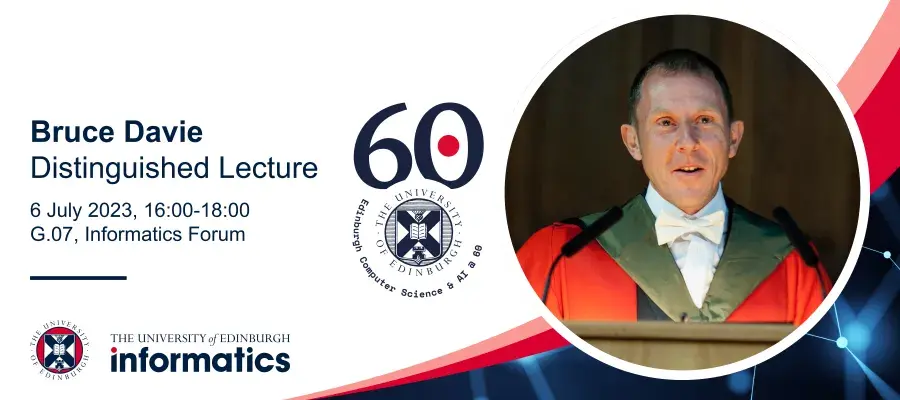Interview with Bruce Davie
As part of the 60 years of computer science and AI celebration, distinguished researchers from both disciplines have been invited to visit the School of Informatics. We have asked them to tell us about their research. Bruce Davie is a computer scientist noted for his contributions to the field of networking, a recipient of the honorary doctorate from Edinburgh University
Title: 60 Years of Networking
Lecture abstract
Building on foundational research on packet switching from the early 1960s, the ARPANET came to life in 1969. The central ideas and first implementations of the Internet followed soon afterwards, although it was another couple of decades before the World Wide Web made the Internet accessible to a broad community of users. Today, the Internet continues to be an amazingly successful distributed system, but the organisation of services is increasingly centralised. From the perspective of many users, the Internet consists of a handful of massive, logically centralised services such as Google, Netflix, and the major social networks. This is a source of concern for those of us who have worked on Internet technology since the early days, because decentralisation was a core tenet of the Internet’s design philosophy.
Much of the success of the Internet, including its robustness in the face of localised failures, its support of diverse users and applications, and the innovation it fostered, can be traced back to decentralisation. We revisit the design philosophy of the Internet as laid out in the 1970s and 1980s, and examine how the Internet’s decentralised architecture fueled its amazing growth. As the World Wide Web took off in the 1990s, efforts to build decentralised search engines were eventually overtaken by events (and one dominant, centralised search engine). The days when individual users would craft web pages to host their own content on a decentralised Web have largely faded into history as centralised social networks took over. Centralisation is not all bad news: the development of centralised abstractions to manage networks (notably in the software-defined networking movement) was one of the most significant innovations in networking of the 2000s (at which I had a ringside seat).
In today’s Internet, excessive centralisation has introduced single points of failure and a stifling of innovation. A recent example is the sudden disabling of API access to a large social network, leaving researchers and commercial entities stranded. But there are signs of movement back to decentralisation; one example is the increasing popularity of “The Fediverse”. We will look at the potential positive impact of the Internet returning to its decentralised roots. This talk will be extensively illustrated by examples from my career in developing and explaining Internet technologies.
Speaker's bio
Bruce Davie is a computer scientist noted for his contributions to the field of networking. He co-founded Systems Approach, LLC, a company developing open source computer science books and educational materials. He is a former CTO for the Asia Pacific region at VMware. He joined VMware during the acquisition of Software Defined Networking (SDN) startup Nicira. Prior to that, he was a Fellow at Cisco Systems, leading a team of architects responsible for Multiprotocol Label Switching (MPLS). Davie has over 30 years of networking industry experience and has co-authored numerous Internet standards. He was recognized as an ACM Fellow in 2009 and chaired ACM SIGCOMM from 2009 to 2013. He was also a visiting lecturer at the Massachusetts Institute of Technology for five years. Davie is the author of multiple books and the holder of more than 40 U.S. Patents. He received an honorary doctorate from Edinburgh University in 2013.


